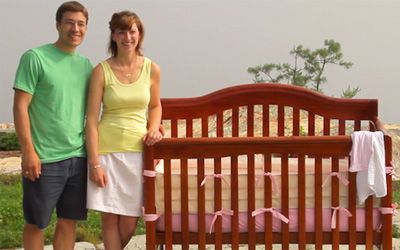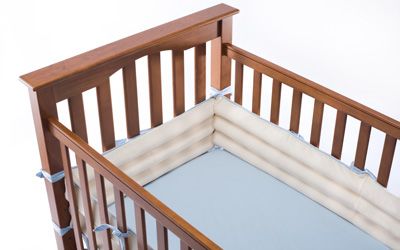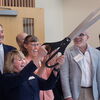Inventors of safer baby bumper prepare for production
Over the past two years, new parents Seabren and Whitney Reeves have spent countless nights burning the midnight oil putting their two young sons to sleep and building a company to help millions of children to sleep more soundly and safely.
“There are about 10,000 annual crib-related injuries [in the U.S. each year],” says Seabren Reeves, president and co-founder of Bitzy Baby. “Forty percent affect the neck or the head and that's why it's so important to have a bumper.”
Seabren and Whitney’s company in May received a utility patent for a crib cushion made of breathable material that protects a young child from hitting the bars of a crib. The combination of breathability and protection is the heart of the couple’s innovation. The Brunswick company’s product uses a semi-rigid webbed insert that provides a cushion against crib railings and allows air to pass through. That design also collapses under pressure from above, preventing a baby from using the pad to climb up and out of the crib.
The couple is in the throes of financing the product’s development and positioning it for international markets.
Market forces
Some older crib bumpers use dense, non-breathable material that poses a danger for babies who might roll over and suffocate against the bumper, Whitney says.
It’s not just cautious parents who are calling for safer crib bumpers. In June, the nation’s first ban on crib bumper pads went into effect in Maryland, where officials cited advice from the American Academy of Pediatrics, the Centers for Disease Control and Prevention and the National Institutes of Health. The city of Chicago in 2011 became the first city in the United States to issue a similar ban.
Those bans do not prohibit sales of mesh bumpers and breathable cushions like Bitzy Baby’s. The restrictions pare away some competitors, but the couple isn’t counting on regulation to make a market for their invention.
In 2011, the company won a student business plan competition at the University of Southern Maine and received funding from Maine Technology Institute and the Libra Future Fund to file for patents and compare their design to other products on the market. Last week, the couple launched a crowdfunding effort to commercialize their invention by next summer.
Whitney, CEO and co-founder, says the decision to pursue that method of financing through the website Indiegogo will allow the couple to keep full ownership of their company and gain exposure through the social media outreach a successful crowdfunding campaign requires. The couple intends to position the company for the international children's product market estimated at around $12 billion. Seabren Reeves says that patching together grants, awards and personal financing will allow the company to avoid a premature valuation of Bitzy Baby.
“It's hard to know what the value of your company will be,” Seabren says. “While we have the resources to fund it ourselves and involve a wider net [of funding], that's the route we've chosen at this point.”
Out of the 4 million children born annually in the United States, Seabren says around 1.4 million are born to parents in the company’s target demographic, ages 25-35 and up. Measuring that market in dollars, the Juvenile Products Manufacturers Association put U.S. sales of children’s products at around $2.8 billion for 2011, the most recent year surveyed. Of that, Seabren says about $196 million falls into the category of bedding and linens, including crib bumpers.
In November, Seabren says the company plans to apply to the Maine Technology Institute for a development loan — up to $500,000 — that would put the product on a track for manufacturing by next summer. Such a loan would require an investment match from the company within a year, which the couple says they hope to raise internally without seeking venture capital or other sources of funding.
Seabren says they hope to have some of the manufacturing performed in Maine although textiles are likely to be imported. They intend to seek distribution through retailers like Babies “R” Us, affiliates in the U.S. and through an international licensing agreement the company negotiated earlier this year at the ABC Kids Expo, a yearly gathering of manufacturers and retailers of children’s products.
That three-year licensing deal gives the company potential distribution in 42 countries. In three-to-five years, the company hopes to have international distribution, says Seabren.
“We're realistic about how long it takes to get a product to market,” he says. “When you throw in language barriers, that gets more complicated and we want to make sure that we're taking the right steps and putting quality first.”
After securing a patent in the United States, a milestone for Bitzy Baby, the company is filing for international patents, staking out that territory before putting its product to market.
“There's a lot of excitement now around the market opportunity without the fear that the patent is going to be rejected or the financing isn't going to be there to fund what we've done,” Seabren says. “That's a very exciting point in the business.”
















Comments